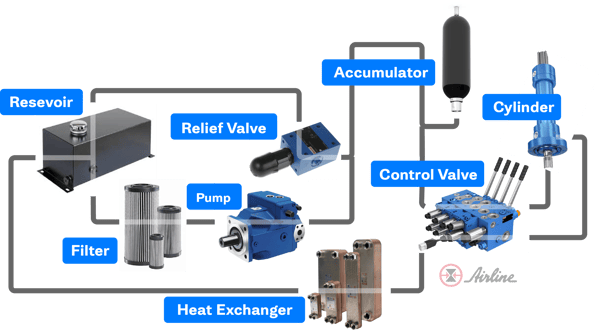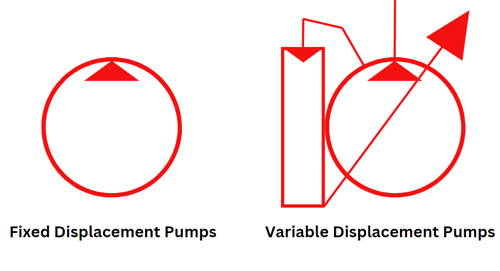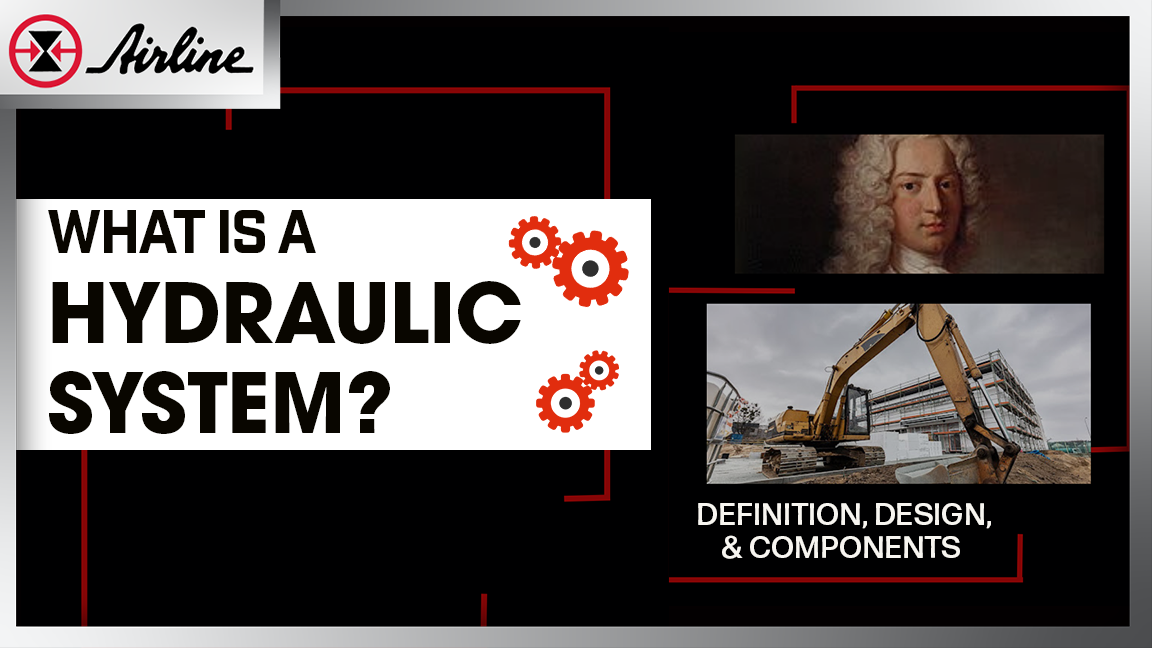From massive excavators shaping our landscapes to industrial machinery driving production, hydraulic systems power much of the modern world. These systems use pressurized fluid to generate force, making them indispensable in industries such as construction, manufacturing, and energy. But what is a hydraulic system, and what makes it so essential?
In this comprehensive guide, we’ll break down hydraulic systems, exploring their definition, core functions, and the key hydraulic components that keep them running smoothly. By the end, you'll have a clear understanding of how these systems work and why they are vital to so many industries. Let’s dive in!
Skip to a Section
What is Hydraulics? | How Does a Hydraulic System Work? | Designing Hydraulic Systems | Hydraulic Circuits: The Backbone of Hydraulics Systems | Fixed Displacement Pumps vs. Variable Displacement Pumps | Industrial Hydraulics vs. Mobile Hydraulics | The Bigger Picture | Expert Resources
Need a quick reference?
Bookmark our Fluid Power Schematic Symbols guide for easy access anytime.
What is Hydraulics?
Hydraulics, or fluid power, is a technology and applied science that harnesses the power of pressurized liquids to transmit force and energy. It's a reliable and effective solution for previously impossible tasks, like effortlessly hoisting heavy loads. It's also a subset of fluid mechanics, which delves into the scientific properties and uses of liquids. Now, you might be thinking, "That sounds complex!" But hold on, it's about to get even more interesting!
How Does a Hydraulics System Work?
Hydraulic systems are built upon and operate based on fundamental scientific principles, known as Pascal's law and Bernoulli's Principle. Let's dust off our history books and dive into the old history of hydraulic energy!
Watch Now >> Hydraulics Explained | What is Hydraulics and How Does it Work?
Pascal's Law
 From the image of its founder, physicist Blaise Pascal, it becomes clear that this scientific law has a rich history dating back to 1653. Pascal's Law states that pressure changes in an enclosed fluid are transmitted equally in all directions. When pressure is applied to one point of an incompressible fluid, it is immediately transmitted to all other parts without loss. This principle is the basis of hydraulic systems, enabling machines to perform large-scale tasks easily and precisely.
From the image of its founder, physicist Blaise Pascal, it becomes clear that this scientific law has a rich history dating back to 1653. Pascal's Law states that pressure changes in an enclosed fluid are transmitted equally in all directions. When pressure is applied to one point of an incompressible fluid, it is immediately transmitted to all other parts without loss. This principle is the basis of hydraulic systems, enabling machines to perform large-scale tasks easily and precisely.
Applying this law to real-world hydraulic systems, a liquid (usually oil) flows from an area of high pressure to an area of low pressure, transmitting power along the way. Fluid flows under pressure through a network of pipes, hoses, and valves to generate force and motion. This movement is created by the pressurized fluid acting on a piston, causing it to move up or down, which, in turn, moves the machinery to perform a specific action. Pretty neat, right?
Bernoulli's Principle
 Bernoulli's Principle, established in 1738 by Daniel Bernoulli, is another pillar of fluid mechanics, which is closely tied to the operation of hydraulic systems. According to this principle, an increase in the speed of a fluid occurs simultaneously with a decrease in the fluid's pressure or potential energy. In simpler terms, the faster a fluid flows, the less pressure it exerts. For hydraulic systems, this principle is crucial when managing the flow rate of the hydraulic fluid. Modern hydraulic systems utilize Bernoulli's principle to optimize pressure and fluid velocity throughout the system, ensuring efficient operation while minimizing energy loss.
Bernoulli's Principle, established in 1738 by Daniel Bernoulli, is another pillar of fluid mechanics, which is closely tied to the operation of hydraulic systems. According to this principle, an increase in the speed of a fluid occurs simultaneously with a decrease in the fluid's pressure or potential energy. In simpler terms, the faster a fluid flows, the less pressure it exerts. For hydraulic systems, this principle is crucial when managing the flow rate of the hydraulic fluid. Modern hydraulic systems utilize Bernoulli's principle to optimize pressure and fluid velocity throughout the system, ensuring efficient operation while minimizing energy loss.
Designing Hydraulic Systems
The design of a hydraulic system is not a one-size-fits-all approach. It involves careful planning, consideration of various factors, and customization to meet specific requirements. Some essential elements to keep in mind when designing a hydraulic system include the type and performance of the pump, fluid selection, potential operating temperatures, speed and accuracy requirements, and safety considerations. Additionally, it's crucial to understand the basics of a hydraulic circuit, each component's function within the system, and how they work together to achieve the desired outcome.
Hydraulic Circuits: The Backbone of Hydraulics Systems
A hydraulic circuit is a series of interconnected components through which hydraulic fluid flows. The primary purpose of this circuit is to achieve a specific task, such as lifting a heavy object, through the transmission of the fluid's power.
The design and complexity of hydraulic circuits can vary significantly depending on the system's requirements. Simple circuits might include a pump, valve, and actuator. Meanwhile, more complex systems could have multiple pumps, various types of valves, and several actuators, all working together to perform intricate tasks. Despite their complexity, all hydraulic circuits share the fundamental principle of channeling pressurized fluid to generate power and accomplish work.
Below is a visual of a typical hydraulic circuit:

Understanding Hydraulic Components
A typical hydraulic circuit consists of these basic components:
Note: It's recommended to work with a hydraulic systems specialist, like Airline, to select the appropriate hydraulic components for your system.
Hydraulic Reservoir
 The reservoir is an essential storage unit where the hydraulic fluid is kept and drawn from when needed. Besides storing the fluid, the reservoir allows for sediment and other contaminants to settle, as well as releasing excess heat. Hydraulic reservoirs come in various types, such as L-shaped, upright, and saddle, each with its unique attributes and applications.
The reservoir is an essential storage unit where the hydraulic fluid is kept and drawn from when needed. Besides storing the fluid, the reservoir allows for sediment and other contaminants to settle, as well as releasing excess heat. Hydraulic reservoirs come in various types, such as L-shaped, upright, and saddle, each with its unique attributes and applications.
Mobile Applications require a compact and efficient tank design due to onboard space, weight, and environmental limitations. Saddle reservoirs are often found on trucks due to their optimal fit around the vehicle's driveline.
When specifying a reservoir for your application, key factors to consider include the system's fluid volume requirement, heat dissipation needs, and the available space. The reservoir should have enough capacity to hold the system's entire fluid volume, allow heat to dissipate effectively, and fit within the available space constraints. It's crucial to choose the right type and size of reservoir to ensure optimal system performance and longevity.
Hydraulic Filter
 As the fluid leaves the reservoir, it passes through the filter, a crucial component in maintaining the cleanliness and efficiency of the hydraulic fluid. The filter's function is to remove foreign particles and prevent component damage, reduce wear and tear, and extend the hydraulic systems' lifespan.
As the fluid leaves the reservoir, it passes through the filter, a crucial component in maintaining the cleanliness and efficiency of the hydraulic fluid. The filter's function is to remove foreign particles and prevent component damage, reduce wear and tear, and extend the hydraulic systems' lifespan.
There are several types of hydraulic filters, including suction filters, pressure filters, return filters, and offline or bypass filters. Suction filters are placed in the reservoir's suction line to purify the fluid before it enters the pump. Pressure filters are located in the pressure line and clean the fluid before it reaches the hydraulic actuator. Return filters cleanse the fluid as it returns to the reservoir, while offline filters continuously filter a portion of the fluid irrespective of the system's operation.
When specifying a hydraulic filter, consider the system's cleanliness requirements, operating pressure, flow rate, and the filter's dirt-holding capacity. It's advisable to consult with a hydraulics specialist or the equipment manufacturer to select the most suitable filter type for your application. Learn more about
Fluid Cleanliness from our Knowledge Center
Remove air from your hydraulic system using an Air Separation Return Filter
Heat Exchanger
 Next, the fluid flows through the heat exchanger, which maintains the fluid at an optimal temperature. By removing heat from the fluid, the heat exchanger maintains the temperature within the ideal range for the system's operation.
Next, the fluid flows through the heat exchanger, which maintains the fluid at an optimal temperature. By removing heat from the fluid, the heat exchanger maintains the temperature within the ideal range for the system's operation.
There are three main types of hydraulic heat exchangers: air-cooled, water-cooled, and oil-cooled. Air-cooled exchangers use ambient air to cool the hydraulic fluid, while water-cooled exchangers utilize a secondary water supply. Oil-cooled exchangers, on the other hand, use a separate oil loop for cooling.
When specifying a heat exchanger for your application, it's vital to consider factors such as the operating temperature range, the system's heat dissipation requirements, and the environment in which the system will operate. Environmental considerations may include the availability of a water source for water-cooled exchangers or the ambient temperature for air-cooled exchangers.
Hydraulic Pumps

Hydraulic pumps convert mechanical, usually rotational, energy into fluid pressure, playing a vital role in hydraulic systems. The fluid pressure is then transported to cylinders, actuators, and hydraulic motors, arriving at the required pressure level and volume. This energy transformation process is crucial.
Gear Pumps
Gear pumps are a popular type of hydraulic pump, known for their simplicity, efficiency, and cost-effectiveness. They work on the displacement principle and involve two gears rotating against each other. As the gears rotate, they create a vacuum on the pump's inlet side, which draws hydraulic fluid from the reservoir. The fluid is then trapped between the gear teeth and the pump casing, and as the gears continue to rotate, the fluid is pushed out of the pump’s outlet side. Gear pumps produce a constant hydraulic flow and are typically categorized as fixed displacement pumps, which pump a consistent amount of fluid for each revolution.
Vane Pumps
Vane pumps operate on a similar displacement principle but use a different mechanism. Inside a vane pump, a series of vanes mounted on a rotor spins inside a cavity. As the rotor spins, centrifugal force extends the vanes from their slots, creating chambers between them. These chambers fill with fluid as they pass the inlet port, transporting the fluid around the pump casing and discharging it as the chambers decrease in volume. Like gear pumps, vane pumps are commonly used as fixed displacement pumps, but designs for variable displacement vane pumps also exist, allowing for adjustments in flow rate.
Piston Pumps
Piston pumps are more complex and versatile than gear or vane hydraulic pumps. They use a series of reciprocating pistons to draw in and discharge hydraulic fluid. The pistons' movement alternately increases and decreases the volume of the fluid chamber, creating suction and discharge actions. Piston pumps can be either fixed or variable displacement, depending on the design. A fixed displacement piston pump delivers a fixed amount of fluid per revolution, while a variable displacement piston pump allows the volume of fluid delivered to be varied, providing greater control over the flow rate and system pressure.
Fixed Displacement Pumps vs. Variable Displacement Pumps
Fixed displacement pumps, as the name suggests, deliver a fixed volume of fluid with each revolution. This volume cannot be varied, meaning the pump produces a constant flow rate that is dependent only on the pump speed. Fixed displacement hydraulic pumps are simpler, more reliable, and less expensive, making them suitable for a wide range of hydraulic systems.
In contrast, variable displacement pumps can vary the volume of fluid delivered with each revolution. This allows for control over the pump's flow rate and system pressure, providing greater flexibility and efficiency, especially in systems with varying load demands. However, variable displacement pumps are more complex and costly than fixed displacement pumps. They are typically used in advanced hydraulic systems where precise control and high efficiency are required.
When specifying a hydraulic pump, consider the system's flow requirements, pressure ratings, and the environment in which the system will operate. Also look at the nature of the load (whether it's constant or variable), system efficiency, and cost considerations.

Relief Valve
 The relief valve acts as a safety device, preventing the system from over-pressurization by releasing the excess fluid back into the reservoir when the pressure exceeds a preset limit. Acting as a failsafe, they regulate system pressure and prevent potential damage due to over-pressurization. When the system's pressure exceeds a defined threshold, the relief valve opens to allow excess fluid to return to the reservoir, thus relieving the pressure.
The relief valve acts as a safety device, preventing the system from over-pressurization by releasing the excess fluid back into the reservoir when the pressure exceeds a preset limit. Acting as a failsafe, they regulate system pressure and prevent potential damage due to over-pressurization. When the system's pressure exceeds a defined threshold, the relief valve opens to allow excess fluid to return to the reservoir, thus relieving the pressure.
Two main relief valves are used in hydraulic systems: direct-acting and pilot-operated. Direct-acting relief valves have a simple construction and open proportionally with increased pressure. Pilot-operated relief valves, on the other hand, are more complex and involve a main valve controlled by a pilot valve. When specifying a hydraulic relief valve, key factors to consider include the system's maximum allowable pressure, the rate of flow, and the level of pressure fluctuation tolerated.
Accumulator
 Once the hydraulic fluid has been compressed, it flows toward the accumulator, which stores hydraulic energy within the system. In other words, the hydraulic power can now be released whenever the system requires it.
Once the hydraulic fluid has been compressed, it flows toward the accumulator, which stores hydraulic energy within the system. In other words, the hydraulic power can now be released whenever the system requires it.
Accumulators come in several types, including piston accumulators, bladder accumulators, and diaphragm accumulators. Piston accumulators use a piston to separate the hydraulic fluid from the gas, while bladder accumulators use a synthetic rubber bladder, and diaphragm accumulators use a diaphragm.
The choice of accumulator depends on several factors, such as the hydraulic system's flow rate requirements, the maximum operating pressure, the temperature range, and the volume of fluid required to be stored. It's imperative to evaluate these parameters accurately to select the appropriate accumulator for your hydraulic system. Learn more about Accumulators in our Accumulator - Frequently Asked Questions(FAQ)
Control Valves (Levers)
 Once that stored hydraulic energy in the accumulator is released, it needs to know where to go to get the job done. That's why control valves, or levers, are fundamental components of a hydraulic system, directing the flow of hydraulic fluids to different parts of the system. They ensure the accurate and efficient operation of the hydraulic system by controlling the fluid flow rate, direction, and pressure exerted.
Once that stored hydraulic energy in the accumulator is released, it needs to know where to go to get the job done. That's why control valves, or levers, are fundamental components of a hydraulic system, directing the flow of hydraulic fluids to different parts of the system. They ensure the accurate and efficient operation of the hydraulic system by controlling the fluid flow rate, direction, and pressure exerted.
There are several types of control valves, including directional control valves, pressure control valves, and flow control valves. Directional control valves guide the flow path of hydraulic fluids, pressure control valves regulate the system pressure, and flow control valves manage the fluid flow rate.
When specifying a hydraulic control valve, one should consider the number of fluid paths (known as "ways") needed, the desired flow direction (known as "positions"), the required flow rate, operating pressure, and the valve's actuation method.
Hydraulic Cylinders and Hydraulic Motors

Lastly, the pressurized fluid enters the muscle of the hydraulic system: The hydraulic cylinder or hydraulic motor, where it creates the mechanical force for the application.
Hydraulic cylinders, often used in applications requiring linear motion, can be either single-acting (where pressure is applied only in one direction, and the cylinder returns to its original position under load gravity or an external force) or double-acting (where pressure is applied in both extending and retracting directions).
Hydraulic motors, on the other hand, provide rotary force and come in a variety of types, including gear, piston, and vane motors.
When specifying a hydraulic cylinder or motor, it's crucial to consider factors such as the system's operating pressure, the speed and force (or torque) needed, the type of motion your hydraulic equipment requires (linear or rotary), and the space available for installation.
Industrial Hydraulics vs. Mobile Hydraulics
What do they have in common? Well, they both flow with power and precision! But regarding their differences, mobile hydraulics goes wherever the action is, while industrial hydraulics keeps things steady and strong in one place.
 Industrial hydraulic systems are typically stationary and operate in a controlled environment like a factory or warehouse. These systems often have a more constant load and are designed for high power, precision, and durability.
Industrial hydraulic systems are typically stationary and operate in a controlled environment like a factory or warehouse. These systems often have a more constant load and are designed for high power, precision, and durability.
Their main components, including pumps, reservoirs, and heat exchangers, are usually larger and more robust to handle higher pressures and flow rates. Additionally, industrial hydraulic systems often have more complex control systems to handle intricate tasks and multiple operations concurrently.
 On the other hand, mobile hydraulic systems are utilized in heavy equipment such as excavators, cranes, agricultural machines and construction equipment. Unlike their industrial counterparts, these systems must be compact, lightweight, and highly efficient due to space and weight constraints.
On the other hand, mobile hydraulic systems are utilized in heavy equipment such as excavators, cranes, agricultural machines and construction equipment. Unlike their industrial counterparts, these systems must be compact, lightweight, and highly efficient due to space and weight constraints.
Mobile hydraulic systems often operate in harsher environments and must be designed to withstand variations in temperature, vibration, and shock. They typically use gear or piston pumps due to their high efficiency and resilience. Additionally, mobile hydraulic reservoirs are smaller and often use L-shaped or saddle designs to fit within the space constraints of the machinery.
Despite these differences, industrial and mobile hydraulic systems both use the magical principles of fluid mechanics and comprise key component superheros like reservoirs, pumps, filters, heat exchangers, control valves, and actuators. Furthermore, both types of systems need to be carefully designed and maintained to ensure optimal performance, efficient operation, and extended lifespan.
The Bigger Picture
![]() Hydraulic systems are versatile and robust, finding applications in almost all industries and mobile settings. Their popularity stems from their exceptional power, efficiency, and precision. Their essential components, such as reservoirs, pumps, filters, heat exchangers, control valves, and actuators, play a vital role in hydraulic equipment operation.
Hydraulic systems are versatile and robust, finding applications in almost all industries and mobile settings. Their popularity stems from their exceptional power, efficiency, and precision. Their essential components, such as reservoirs, pumps, filters, heat exchangers, control valves, and actuators, play a vital role in hydraulic equipment operation.
When designing and selecting these components, various factors come into play, including system requirements, load demands, operating environment, and cost considerations. Gaining a thorough understanding of these components and their functions proves invaluable for achieving optimal design and operation of hydraulic systems.
Expert Resources
For all your hydraulic energy needs, trust us, Airline Hydraulics. Our knowledgeable team specializes in providing high-quality hydraulic components that meet your system requirements. We offer top-tier products from leading manufacturers and can create customized hydraulic systems for your unique applications. Experience the difference of working with true hydraulic experts.










Leave Comment